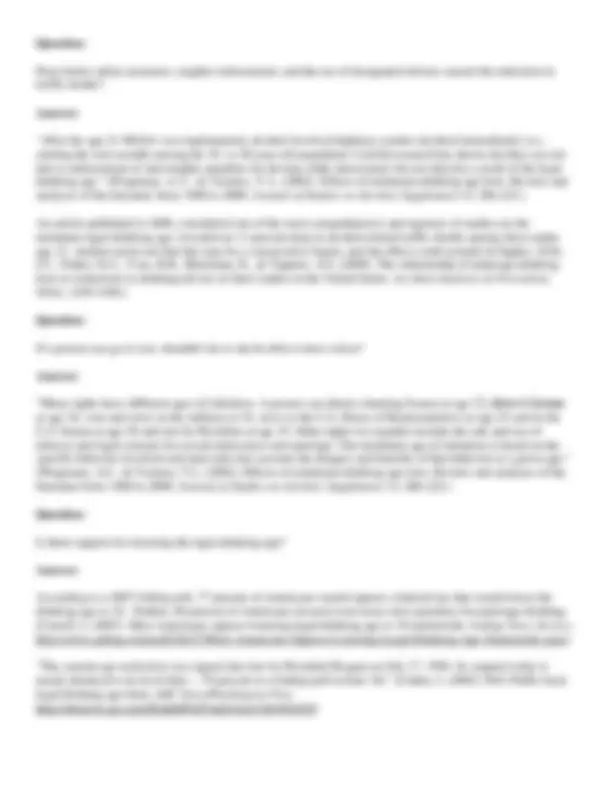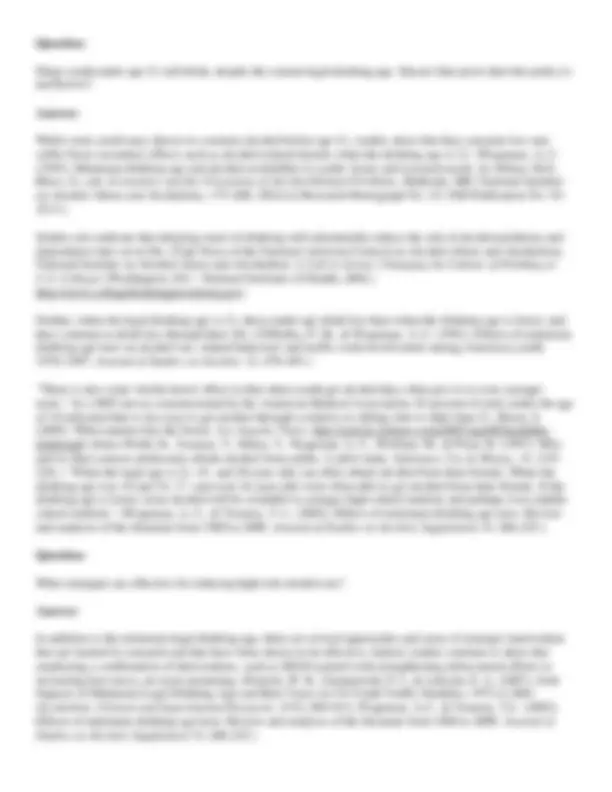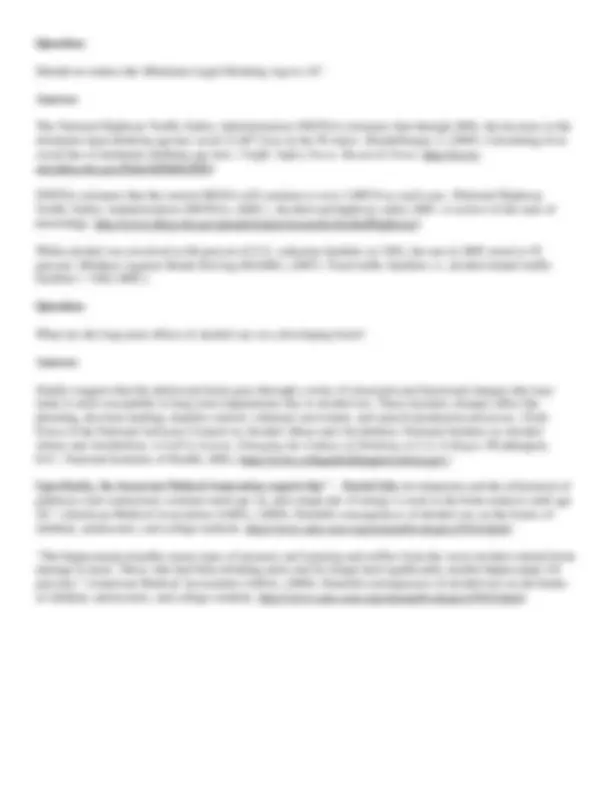





Study with the several resources on Docsity

Earn points by helping other students or get them with a premium plan


Prepare for your exams
Study with the several resources on Docsity

Earn points to download
Earn points by helping other students or get them with a premium plan
Community
Ask the community for help and clear up your study doubts
Discover the best universities in your country according to Docsity users
Free resources
Download our free guides on studying techniques, anxiety management strategies, and thesis advice from Docsity tutors
The comparison of alcohol consumption rates and related problems between European countries and the United States. It also explores the impact of legal drinking ages on youth drinking and traffic crashes. The document also touches upon the debate on the most appropriate age for legal access to alcohol.
What you will learn
Typology: Lecture notes
1 / 6

This page cannot be seen from the preview
Don't miss anything!




Question:
Youth in other countries are exposed to alcohol at earlier ages and engage in less alcohol abuse and have healthier attitudes toward alcohol. Don't those countries have fewer alcohol-related problems than we do?
Answer:
Actually, that is a myth. Despite anecdotal reports of adults teaching youth to drink in moderation, survey data provide no evidence that European youth are more responsible about alcohol consumption than American youth. A recent study compared rates of alcohol consumption and alcohol-related problems in the United States with those in Europe and found that both rates and frequency of drinking among European youth are higher than in the United States. Additionally, about half of the European countries surveyed had higher rates of intoxication among their youth. (Grube, J. W. (2005). Youth drinking rates and problems: A comparison of European countries and the United States. Calverton, MD: Pacific Institute for Research and Evaluation, Office of Juvenile Justice Enforcing the Underage Drinking Laws Program.)
Further, "…a greater percentage of young people from nearly all European countries in the survey report drinking in the past 30 days. For a majority of these European countries, a greater percentage of young people report having five or more drinks in a row. (Grube, J. W. (2001). Comparison of drinking rates and problems: European countries and the United States. Calverton, MD: Pacific Institute for Research and Evaluation, Office of Juvenile Justice Enforcing the Underage Drinking Laws Program.) Additionally, per capita consumption of alcohol and cirrhosis death rates are both higher in France and Italy, two countries with a lower legal drinking age.‖ (Wagenaar, A. C., & Toomey, T. L. (2002). Effects of minimum drinking age laws: Review and analyses of the literature from 1960 to 2000. Journal of Studies on Alcohol, Supplement 14, 206-225.)
Reports of fewer alcohol-related crashes among European youth are likely due to youth driving "…less frequently in Europe than in the United States. Compared with the United States, Europeans have higher legal driving ages, more expensive automobiles, and greater access to public transportation. Looking beyond traffic crashes, however, European countries have similar or higher rates of other alcohol-related problems compared with the United States." (Wagenaar, A. C., & Toomey, T. L. (2002). Effects of minimum drinking age laws: Review and analyses of the literature from 1960 to 2000. Journal of Studies on Alcohol, Supplement 14, 206- 225.)
―European countries are now looking to the United States for research and experience regarding the age- policy. Europeans are initiating the debate on the most appropriate age for legal access to alcohol.‖ (Wagenaar, A. C., & Toomey, T. L. (2002). Effects of minimum drinking age laws: Review and analyses of the literature from 1960 to 2000. Journal of Studies on Alcohol, Supplement 14, 206-225.)
Does educating teens about safe alcohol use starting at age 18 encourage responsible drinking?
Answer:
Alcohol education programs have been in place for years and have been proven by numerous studies to be ineffective at reducing high-risk drinking and other risky behavior when used in isolation. (Wagenaar, A. C., & Toomey, T. L. (2002). Effects of minimum drinking age laws: Review and analyses of the literature from 1960 to 2000. Journal of Studies on Alcohol, Supplement 14, 206-225; Task Force of the National Advisory Council on Alcohol Abuse and Alcoholism, National Institute on Alcohol Abuse and Alcoholism. A Call to Action: Changing the Culture of Drinking at U.S. Colleges (Washington, D.C.: National Institutes of Health, 2002.) http://www.collegedrinkingprevention.gov)
Question:
Has the minimum legal drinking age been lowered before? What were the results of that "natural experiment"?
Answer:
"Between 1970 and 1975, 29 states lowered their minimum drinking ages. Meanwhile, 13 states kept the legal age at 21." Researchers found a marked increase in alcohol-related teen car crashes in the states with reductions. "Once the 21 age was restored…alcohol-involved highway crashes immediately declined in this age group." (Wagenaar, A. in Mothers Against Drunk Driving (MADD). (2004, Spring). ―21‖ turns 20. DRIVEN Magazine. http://www.madd.org/getattachment/c7548643-ced8-47b6-8fd5-b0f92d00e9df/-21--Turns-20.aspx)
New Zealand lowered its minimum purchase age for alcohol from 20 to 18 in 1999. Researchers noted in 2006 that "…significantly more alcohol-involved crashes occurred among 15- to 19-year-olds than would have occurred had the purchase age not been reduced to 18 years. The effect size for 18- to 19-year-olds is remarkable given the legal exceptions to the pre-1999 law and its poor enforcement." (Kypri, K., Voas, R., Langley, J., Stephenson, B., Begg, D., Tippetts, S., & Davie, G. (2006). Minimum purchasing age for alcohol and traffic crash injuries among 15- to 19-year-olds in New Zealand. American Journal of Public Health, 96 (1), 126 – 131.)
After the minimum age was lowered, New Zealand researchers found that this change in the minimum drinking age "…has resulted in increased presentations to the [central city emergency department] of intoxicated eighteen and nineteen year olds. A similar trend was seen in the 15-17 year olds." (Everitt, R., & Jones, P. (2002). Changing the minimum legal drinking age—its effect on a central city emergency department. The New Zealand Medical Journal, 115 (1146), 9–11.) Rates of drunk driving and disorderly conduct have also increased. (Join Together Research Summary: http://www.jointogether.org/news/research/summaries/2007/alcohol-crashes-rose-when.html?log-event=sp2f- view-item&nid=32615691)
Many youth under age 21 still drink, despite the current legal drinking age. Doesn't that prove that this policy is ineffective?
Answer:
While some youth may choose to consume alcohol before age 21, studies show that they consume less and suffer fewer secondary effects such as alcohol-related injuries when the drinking age is 21. (Wagenaar, A. C. (1993). Minimum drinking age and alcohol availability to youth: Issues and research needs. In: Hilton, M.E., Bloss, G., eds. Economics and the Prevention of Alcohol-Related Problems. Bethesda, MD: National Institute on Alcohol Abuse and Alcoholism, 175–200. (NIAAA Research Monograph No. 25, NIH Publication No. 93- 3513.)
Studies also indicate that delaying onset of drinking will substantially reduce the risk of alcohol problems and dependence later on in life. (Task Force of the National Advisory Council on Alcohol Abuse and Alcoholism, National Institute on Alcohol Abuse and Alcoholism. A Call to Action: Changing the Culture of Drinking at U.S. Colleges (Washington, D.C.: National Institutes of Health, 2002.) http://www.collegedrinkingprevention.gov)
Further, when the legal drinking age is 21, those under age drink less than when the drinking age is lower, and they continue to drink less through their 20s. (O'Malley, P. M., & Wagenaar, A. C. (1991). Effects of minimum drinking age laws on alcohol use, related behaviors and traffic crash involvement among American youth: 1976 – 1987. Journal of Studies on Alcohol, 52 , 478–491.)
"There is also some 'trickle-down' effect in that when youth get alcohol they often give it to even younger teens." In a 2005 survey commissioned by the American Medical Association, 65 percent of teens under the age of 18 indicated that it was easy to get alcohol through a relative or sibling who is older than 21. (Roan, S. (2005). When parents buy the booze. Los Angeles Times. http://articles.latimes.com/2005/aug/08/health/he- drinking8) (Jones-Webb, R., Toomey, T., Miner, T., Wagenaar, A. C., Wolfson, M., & Poon, R. (1997). Why and in what context adolescents obtain alcohol from adults: A pilot study. Substance Use & Misuse, 32 , 219– 228; ) "When the legal age is 21, 19- and 20-year-olds can often obtain alcohol from their friends. When the drinking age was 18 and 19, 17- and even 16-year-olds were often able to get alcohol from their friends. If the drinking age is lower, more alcohol will be available to younger high school students and perhaps even middle school students." (Wagenaar, A. C., & Toomey, T. L. (2002). Effects of minimum drinking age laws: Review and analyses of the literature from 1960 to 2000. Journal of Studies on Alcohol, Supplement 14, 206-225.)
Question:
What strategies are effective for reducing high-risk alcohol use?
Answer:
In addition to the minimum legal drinking age, there are several approaches and areas of strategic intervention that are backed by research and that have been shown to be effective. Indeed, studies continue to show that employing a combination of interventions, such as MLDA paired with strengthening enforcement efforts or increasing beer taxes, are most promising. (Ponicki, W. R., Gruenewald, P. J., & LaScala, E. A. (2007). Joint Impacts of Minimum Legal Drinking Age and Beer Taxes on US Youth Traffic Fatalities, 1975 to 2001. Alcoholism: Clinical and Experimental Research, 31 (5), 804–813; Wagenaar, A.C., & Toomey, T.L. (2002). Effects of minimum drinking age laws: Review and analyses of the literature from 1960 to 2000. Journal of Studies on Alcohol, Supplement 14, 206-225.)
Should we reduce the Minimum Legal Drinking Age to 18?
Answer:
The National Highway Traffic Safety Administration (NHTSA) estimates that through 2002, the increase in the minimum legal drinking age has saved 21,887 lives in the 50 states. (Kindelberger, J. (2005). Calculating lives saved due to minimum drinking age laws. Traffic Safety Facts: Research Notes. http://www- nrd.nhtsa.dot.gov/Pubs/809860.PDF)
NHTSA estimates that the current MLDA will continue to save 1,000 lives each year. (National Highway Traffic Safety Administration (NHTSA). (2001). Alcohol and highway safety 2001: A review of the state of knowledge. http://www.nhtsa.dot.gov/people/injury/research/AlcoholHighway/)
While alcohol was involved in 60 percent of U.S. vehicular fatalities in 1982, the rate in 2005 stood at 39 percent. (Mothers Against Drunk Driving (MADD). (2007). Total traffic fatalities vs. alcohol related traffic fatalities – 1982-2005.)
Question:
What are the long-term effects of alcohol use on a developing brain?
Answer:
Studies suggest that the adolescent brain goes through a series of structural and functional changes that may make it more susceptible to long-term impairments due to alcohol use. These dynamic changes affect the planning, decision-making, impulse control, voluntary movement, and speech-production processes. (Task Force of the National Advisory Council on Alcohol Abuse and Alcoholism, National Institute on Alcohol Abuse and Alcoholism. A Call to Action: Changing the Culture of Drinking at U.S. Colleges (Washington, D.C.: National Institutes of Health, 2002.) http://www.collegedrinkingprevention.gov)
Specifically, the American Medical Association reports that "…frontal lobe development and the refinement of pathways and connections continue until age 16, and a high rate of energy is used as the brain matures until age 20." (American Medical Association (AMA). (2004). Harmful consequences of alcohol use on the brains of children, adolescents, and college students. http://www.ama-assn.org/ama/pub/category/9416.html)
"The hippocampus handles many types of memory and learning and suffers from the worst alcohol-related brain damage in teens. Those who had been drinking more and for longer had significantly smaller hippocampi ( percent)." (American Medical Association (AMA). (2004). Harmful consequences of alcohol use on the brains of children, adolescents, and college students. http://www.ama-assn.org/ama/pub/category/9416.html)